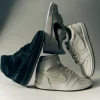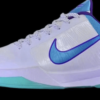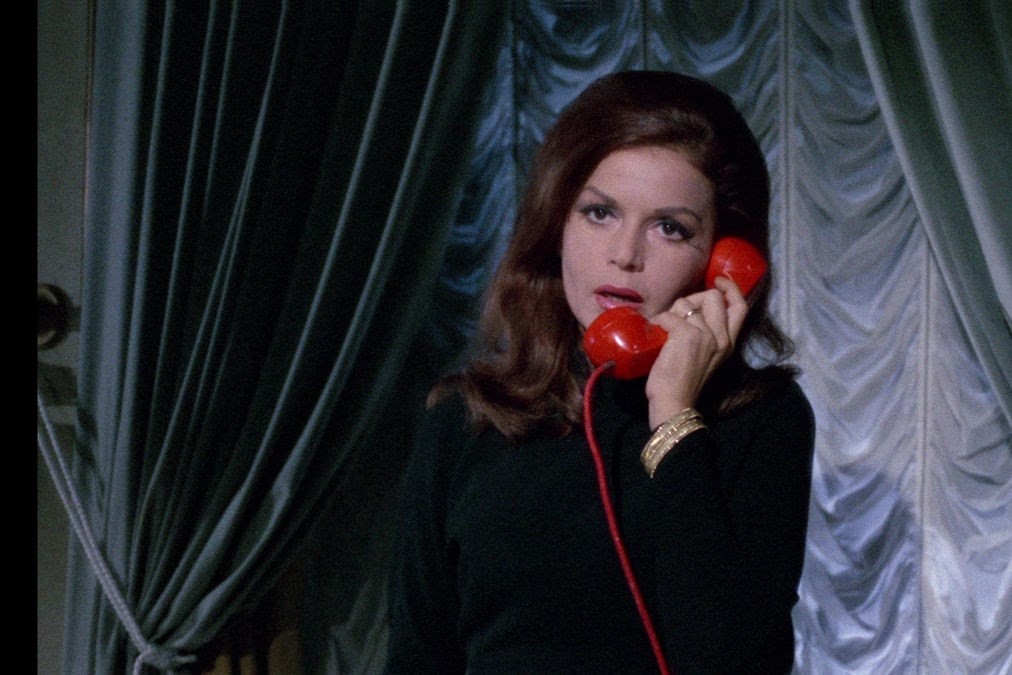
Rewrite
6 horror films with great fashion12 Images
The horror genre includes some of the most critically acclaimed films of all time, but also its fair share of exploitation movies made as cheaply and quickly as possible by people who didn’t really know where they were doing, or were only interested in making a quick buck. This variety makes it especially fertile terrain for fashion. There are horror films which feature specially made pieces and styling from the world’s finest costume designers, and there are horror films which have their characters wearing literally anything, rendering them time capsules preserving long-dead trends and showing us the styles which enjoyed mass popularity at the time.
If you’re looking for fashion inspiration, both ends of the spectrum can be equally valuable: designers have taken inspiration from revered classics like Rosemary’s Baby, but also the sleaziest of 1980s slashers. The horror films listed below are all stylish in their own different ways, from Italian capes and Yves Saint Laurent dresses to army jumpsuits and denim cut-offs.
Emerging in Italy in the 1960s, the giallo genre is renowned for its glamour, elegance and vivid use of colour, and generations of designers have drawn inspiration from it, including Nicolas Ghesquière and Rodarte. Giallo can be thought of as a precursor to the slasher film (there’s often a masked killer picking off a cast of characters one by one), but there’s usually an element of murder mystery: imagine a sexier, more violent version of Inspector Morse.
Like many other films in the genre, Mario Brava’s Blood and Black Lace (1964) is about fashion: in an effort to prevent the contents of a scandalous diary from being made public, a masked killer is out to get a group of models who all work for the fashion house in Rome. The costume design is as elegant as you’d expect from a film set in the world of 1960s Italian couture (even the killer has a lovely raincoat). Most stylish of all is the aloof, sultry Countess Cristina – the owner of the house – who swans around in capes and sleek black tops with a pair of glasses hanging from a pendant around her neck. She’s so cool. I don’t want to say anything else about her because I don’t want to spoil the big reveal at the end, but let’s just say that she did nothing wrong!
Brava’s protege, Dario Argento (best known for Suspiria) also used fashion in his films in a deeply thoughtful and considered way. He worked with designers and consultants to create tailor-made pieces for his characters, understanding how powerfully clothes can convey character and mood. In 1996, he curated a catwalk show for the Italian brand Trussardi, which involved a model being “murdered”, wrapped up in a body bag and dragged off stage.
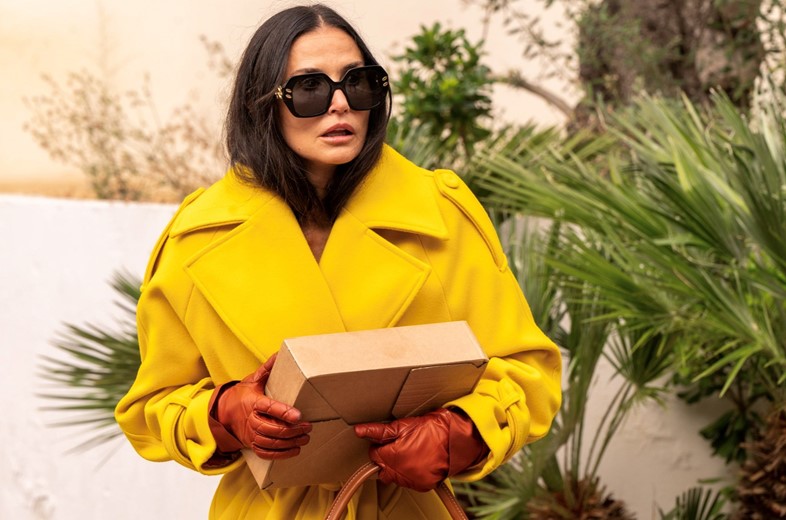
目次
The Substance (2024)
The Substance is a film that dares to ask: what if retinol was evil? Director Coralie Fargeat’s satire of Hollywood’s obsession with youth is not exactly subtle, and the point that it’s bludgeoning you over the head with is perhaps undermined by how much of its horror is derived from the lurid spectacle of the ageing body (‘Oh, so you think being middle-aged is bad? Well, imagine if you turned into a really old crone! That would teach you a lesson!’) But it is a wild ride, entertaining and visually interesting from the very first scene.
On the one hand, The Substance is a film about how tacky American culture is, from the vantagepoint of a French director who seems to disdain it. But amid all the garish sportswear, there are some genuinely great outfits, from the leather jumpsuit Margaret Qualley wears on her first night out to Demi Moore’s yellow coat, which really steals the show.
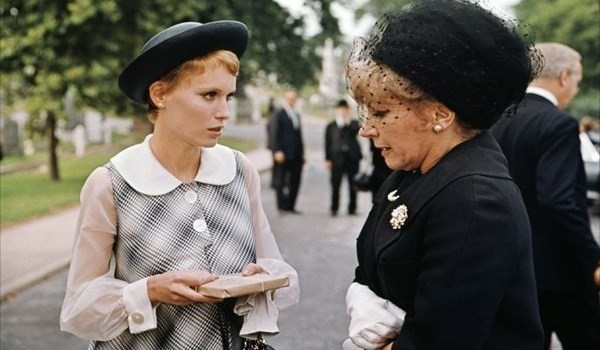
Rosemary’s Baby (1968)
Rosemary’s Baby is many things: a satanic horror story; a psychological thriller about what it’s like to have annoying neighbours, and a critique of the way that patriarchy deprives women of bodily autonomy, making their most intimate experiences a matter of public concern which the whole world is entitled to weigh in on (of course, any feminist reading is complicated by the fact it was directed by alleged rapist Roman Polanksi).
It is also a great snapshot of late 1960s fashion. Working with costume designer Anthea Sylbert, Polanski wanted to lull audiences into a false sense of security by creating an atmosphere of ordinariness. The outfits worn by Rosemary (Mia Farrow) are not especially flamboyant – there’s a lot of muted pastels and airy shift dresses – but instead capture a breezy 60s elegance. Halfway through the film, in an act of rebellion against her coercive husband, she changes her hairstyle to a Vidal Sassoon-inspired pixie cut (her husband hates it, telling her it might be the “worst mistake she’s ever made” – yet more proof of his evil). Rosemary’s Baby has inspired a number of fashion collections over the years, including by Prada, Miu Miu, Calvin Klein and Altuzarra.
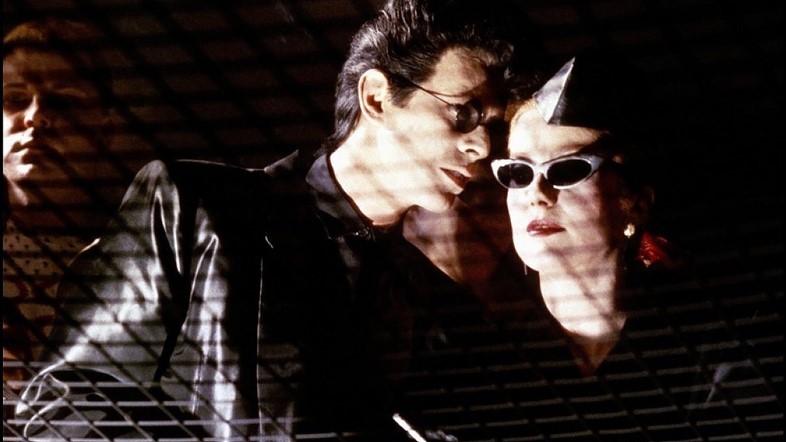
The Hunger (1983)
The Hunger – an erotic horror film about vampires – was a critical and commercial failure upon its release, but has since grown in stature and become a beloved cult classic. It stars David Bowie and Catherine Deneuve as a vampire couple, and Susan Sarandon as a doctor who becomes ensnared in a dangerous love triangle with them. The film’s costumes were designed by Milena Canonera, with many individual pieces created by Yves Saint Laurent. Susan Sarandon is decked out in somewhat androgynous, even butch outfits: white t-shirts, trousers and blazers. Denueve’s character is styled with a noirish, art deco 1930s glamour – netted black face veils, brooches, black-and-gold dresses and cat-eye sunglasses – combined with 80s silhouettes and flashes of punk. David Bowie’s styling is more of the moment, drawing inspiration from the goth subculture and New Romantic movement, but still defined by its razor-sharp tailoring.
Famously, The Hunger inspired Alexander McQueen’s 1996 show of the same name, which saw models take to the runway in blood-stained shirts, slashed garments, and a translucent, moulded corset which contained real, live and writhing worms.
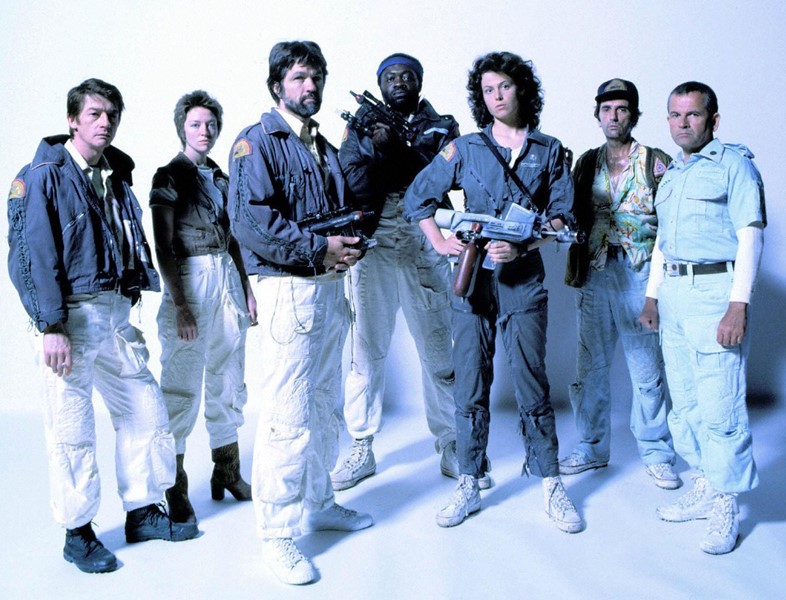
Alien (1979)
While Alien (1979) might not scream high fashion, the film’s unisex, utilitarian costume design has aged surprisingly well – you could flog these clothes for hundreds of pounds if you whacked an ‘Our Legacy’ label on them, and people would definitely be gagged if you walked into a queer club in Dalston today wearing Ripley’s army green jumpsuit.
As well as being a film about an evil creature from outer space, Alien is about a group of colleagues having an incredibly bad day at work, and the humdrum nature of their jobs is conveyed through the costume design, which features overalls, sneakers, white cargo pants, company-branded jackets and sneakers. That said, a couple of characters have kicked back against the uniformity imposed by the (very evil) company they work for and spruced up their outfits: Brett, the loveable goofball played by Harry Dean Stanton, is wearing a garish Hawaiian shirt, and Lambert (Veronica Cartwright) is running around in a pair of patterned cowboy boots.

Sleepaway Camp (1983)
You won’t find much in the way of exquisite costume design in 1980s slasher films, but they can be a great source of fashion inspiration. The characters of these films are usually supposed to be average teenagers, and while they don’t necessarily dress like their real-world equivalents did, their outfits provide some insight into what was considered cool at the time, what clothes would strike the right balance between aspirational and relatable for a teenage audience. The slasher genre gave rise to some timeless looks – Jamie Lee Curtis’s flared jeans, button-up and sweaters in Halloween (very demure), Johnny Depp’s cropped football shirt in Nightmare on Elm Street – but the most flamboyant of them all is Sleepaway Camp: a 1983 also-ran which has since been re-acclaimed as a queer classic.
It only takes one look at the costume design to figure out why: these outfits are unbelievably gay. If you dressed like this and went for a walk just about anywhere in modern-day Britain, there is a considerable chance that someone would shout a slur at you. I have no idea whether heterosexual jocks in the 1980s actually were mincing around in crop tops and cut-off denim short shorts, but the fact you wouldn’t see this represented in popular culture today suggests that we’ve gone backwards. What kind of nightmarish world have we created where straight men don’t feel comfortable strutting around with their midriffs exposed? We need to go back, we need to return to a past which possibly never existed – and Sleepaway Camp can show us the way.
in HTML format, including tags, to make it appealing and easy to read for Japanese-speaking readers aged 20 to 40 interested in fashion. Organize the content with appropriate headings and subheadings (h1, h2, h3, h4, h5, h6), translating all text, including headings, into Japanese. Retain any existing
tags from
6 horror films with great fashion12 Images
The horror genre includes some of the most critically acclaimed films of all time, but also its fair share of exploitation movies made as cheaply and quickly as possible by people who didn’t really know where they were doing, or were only interested in making a quick buck. This variety makes it especially fertile terrain for fashion. There are horror films which feature specially made pieces and styling from the world’s finest costume designers, and there are horror films which have their characters wearing literally anything, rendering them time capsules preserving long-dead trends and showing us the styles which enjoyed mass popularity at the time.
If you’re looking for fashion inspiration, both ends of the spectrum can be equally valuable: designers have taken inspiration from revered classics like Rosemary’s Baby, but also the sleaziest of 1980s slashers. The horror films listed below are all stylish in their own different ways, from Italian capes and Yves Saint Laurent dresses to army jumpsuits and denim cut-offs.
Emerging in Italy in the 1960s, the giallo genre is renowned for its glamour, elegance and vivid use of colour, and generations of designers have drawn inspiration from it, including Nicolas Ghesquière and Rodarte. Giallo can be thought of as a precursor to the slasher film (there’s often a masked killer picking off a cast of characters one by one), but there’s usually an element of murder mystery: imagine a sexier, more violent version of Inspector Morse.
Like many other films in the genre, Mario Brava’s Blood and Black Lace (1964) is about fashion: in an effort to prevent the contents of a scandalous diary from being made public, a masked killer is out to get a group of models who all work for the fashion house in Rome. The costume design is as elegant as you’d expect from a film set in the world of 1960s Italian couture (even the killer has a lovely raincoat). Most stylish of all is the aloof, sultry Countess Cristina – the owner of the house – who swans around in capes and sleek black tops with a pair of glasses hanging from a pendant around her neck. She’s so cool. I don’t want to say anything else about her because I don’t want to spoil the big reveal at the end, but let’s just say that she did nothing wrong!
Brava’s protege, Dario Argento (best known for Suspiria) also used fashion in his films in a deeply thoughtful and considered way. He worked with designers and consultants to create tailor-made pieces for his characters, understanding how powerfully clothes can convey character and mood. In 1996, he curated a catwalk show for the Italian brand Trussardi, which involved a model being “murdered”, wrapped up in a body bag and dragged off stage.

The Substance (2024)
The Substance is a film that dares to ask: what if retinol was evil? Director Coralie Fargeat’s satire of Hollywood’s obsession with youth is not exactly subtle, and the point that it’s bludgeoning you over the head with is perhaps undermined by how much of its horror is derived from the lurid spectacle of the ageing body (‘Oh, so you think being middle-aged is bad? Well, imagine if you turned into a really old crone! That would teach you a lesson!’) But it is a wild ride, entertaining and visually interesting from the very first scene.
On the one hand, The Substance is a film about how tacky American culture is, from the vantagepoint of a French director who seems to disdain it. But amid all the garish sportswear, there are some genuinely great outfits, from the leather jumpsuit Margaret Qualley wears on her first night out to Demi Moore’s yellow coat, which really steals the show.

Rosemary’s Baby (1968)
Rosemary’s Baby is many things: a satanic horror story; a psychological thriller about what it’s like to have annoying neighbours, and a critique of the way that patriarchy deprives women of bodily autonomy, making their most intimate experiences a matter of public concern which the whole world is entitled to weigh in on (of course, any feminist reading is complicated by the fact it was directed by alleged rapist Roman Polanksi).
It is also a great snapshot of late 1960s fashion. Working with costume designer Anthea Sylbert, Polanski wanted to lull audiences into a false sense of security by creating an atmosphere of ordinariness. The outfits worn by Rosemary (Mia Farrow) are not especially flamboyant – there’s a lot of muted pastels and airy shift dresses – but instead capture a breezy 60s elegance. Halfway through the film, in an act of rebellion against her coercive husband, she changes her hairstyle to a Vidal Sassoon-inspired pixie cut (her husband hates it, telling her it might be the “worst mistake she’s ever made” – yet more proof of his evil). Rosemary’s Baby has inspired a number of fashion collections over the years, including by Prada, Miu Miu, Calvin Klein and Altuzarra.

The Hunger (1983)
The Hunger – an erotic horror film about vampires – was a critical and commercial failure upon its release, but has since grown in stature and become a beloved cult classic. It stars David Bowie and Catherine Deneuve as a vampire couple, and Susan Sarandon as a doctor who becomes ensnared in a dangerous love triangle with them. The film’s costumes were designed by Milena Canonera, with many individual pieces created by Yves Saint Laurent. Susan Sarandon is decked out in somewhat androgynous, even butch outfits: white t-shirts, trousers and blazers. Denueve’s character is styled with a noirish, art deco 1930s glamour – netted black face veils, brooches, black-and-gold dresses and cat-eye sunglasses – combined with 80s silhouettes and flashes of punk. David Bowie’s styling is more of the moment, drawing inspiration from the goth subculture and New Romantic movement, but still defined by its razor-sharp tailoring.
Famously, The Hunger inspired Alexander McQueen’s 1996 show of the same name, which saw models take to the runway in blood-stained shirts, slashed garments, and a translucent, moulded corset which contained real, live and writhing worms.

Alien (1979)
While Alien (1979) might not scream high fashion, the film’s unisex, utilitarian costume design has aged surprisingly well – you could flog these clothes for hundreds of pounds if you whacked an ‘Our Legacy’ label on them, and people would definitely be gagged if you walked into a queer club in Dalston today wearing Ripley’s army green jumpsuit.
As well as being a film about an evil creature from outer space, Alien is about a group of colleagues having an incredibly bad day at work, and the humdrum nature of their jobs is conveyed through the costume design, which features overalls, sneakers, white cargo pants, company-branded jackets and sneakers. That said, a couple of characters have kicked back against the uniformity imposed by the (very evil) company they work for and spruced up their outfits: Brett, the loveable goofball played by Harry Dean Stanton, is wearing a garish Hawaiian shirt, and Lambert (Veronica Cartwright) is running around in a pair of patterned cowboy boots.

Sleepaway Camp (1983)
You won’t find much in the way of exquisite costume design in 1980s slasher films, but they can be a great source of fashion inspiration. The characters of these films are usually supposed to be average teenagers, and while they don’t necessarily dress like their real-world equivalents did, their outfits provide some insight into what was considered cool at the time, what clothes would strike the right balance between aspirational and relatable for a teenage audience. The slasher genre gave rise to some timeless looks – Jamie Lee Curtis’s flared jeans, button-up and sweaters in Halloween (very demure), Johnny Depp’s cropped football shirt in Nightmare on Elm Street – but the most flamboyant of them all is Sleepaway Camp: a 1983 also-ran which has since been re-acclaimed as a queer classic.
It only takes one look at the costume design to figure out why: these outfits are unbelievably gay. If you dressed like this and went for a walk just about anywhere in modern-day Britain, there is a considerable chance that someone would shout a slur at you. I have no idea whether heterosexual jocks in the 1980s actually were mincing around in crop tops and cut-off denim short shorts, but the fact you wouldn’t see this represented in popular culture today suggests that we’ve gone backwards. What kind of nightmarish world have we created where straight men don’t feel comfortable strutting around with their midriffs exposed? We need to go back, we need to return to a past which possibly never existed – and Sleepaway Camp can show us the way.
and integrate them seamlessly into the new content without adding new tags. Ensure the new content is fashion-related, written entirely in Japanese, and approximately 1500 words. Conclude with a “結論” section and a well-formatted “よくある質問” section. Avoid including an introduction or a note explaining the process.
